Technology: 2016 Kawasaki Ninja ZX-10R
We recently rode the 2016 Kawasaki Ninja ZX-10R and we absolutely loved it. You can read about what it's like riding one of the best sports bikes available in India here, or you can stay on this page to get a better understanding of the technology that goes into this masterclass of a machine.
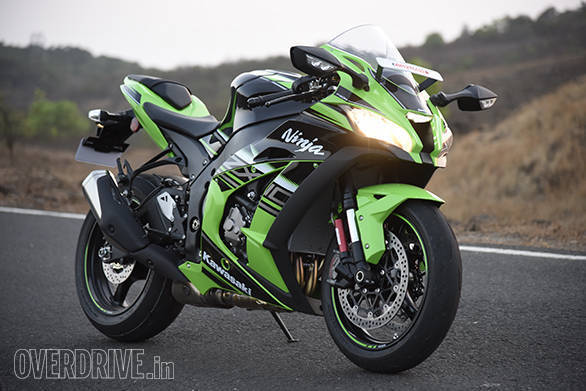
Chassis
Let's start with the chassis. The steering head is now 7.5mm closer to the rider which places more weight on the front end. This creates a new-found agility in the front end but could also make the bike a little unstable. To counter that, the swingarm is now 15.8mm longer, resulting in a longer wheelbase which means better stability. Kawasaki claims the swingarm is also more rigid which is said to aid the nimble handling.
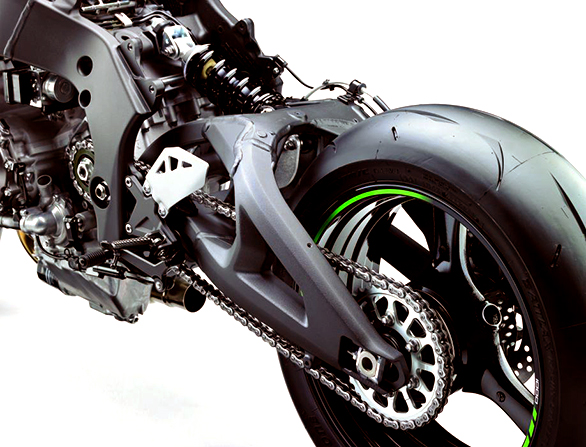 The swingarm has been reincorded and is a 15.8mm longer
The swingarm has been reincorded and is a 15.8mm longer
The two standout features, chassis wise here are the Showa Balance Free Forks and the Brembo M50 brakes. If you read a lot of international reviews, you'll know that these brakes are revered universally as the best systems available on a road bike. For the 2016 10R, Kawasaki increased the front rotor size from 310mm to 330mm, and those twin discs are now bitten upon by a pair of M50 monobloc callipers. Brake lines are now race grade stainless steel braided hoses. Because the discs are now so big, Kawasaki has provided an angled valve on the rim for easier tyre pressure changes.
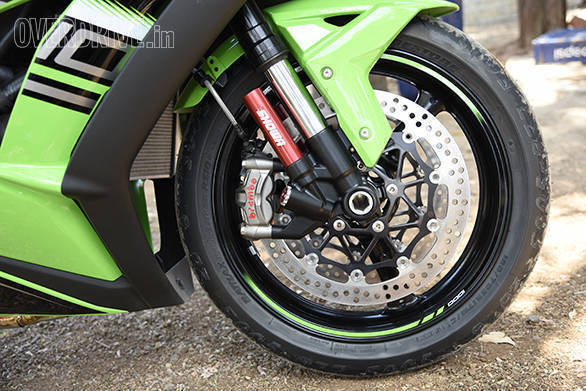 Brembo M50 brakes and the Showa Balance Free Forks make a formidable combination
Brembo M50 brakes and the Showa Balance Free Forks make a formidable combination
Suspension
A more visually identifiable change than the brakes is the new front suspension. The 2016 Kawasaki Ninja ZX-10R is the world's first production motorcycle to offer Showa's new Balance Free Forks. This suspension separates the damping valves in a canister outside the fork legs. This technology was developed in WSBK and aims at eliminating the fluctuations in hydraulic pressure balance that are typically found in conventional forks. With this system, the entire surface of the fork pistons evenly pushes down hydraulic fluid on to the damping valves. Nitrogen gas in the compression chamber pushes back against the hydraulic fluid and this creates balanced pressure in the fork leg.
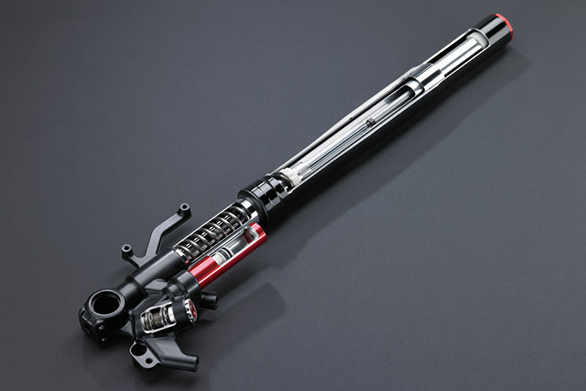 The Balance Free Fork places damping function into a separate canister
The Balance Free Fork places damping function into a separate canister
The result is better low-speed comfort, more traction and more precise front-end feel. Having ridden the bike, we found the technology works beautifully â" low-speed bumps are absorbed well and the bike remains both agile but very confident during high direction changes. The rear shock uses a similar technology called the Balance Free Rear Cushion that also uses a separate damping force chamber.
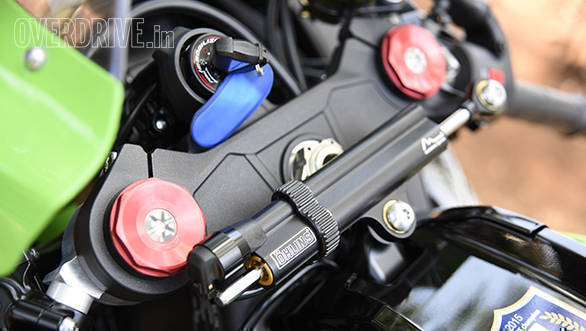 Electric Ohlins steering damper is soft at low revs and firms up as the speed increases
Electric Ohlins steering damper is soft at low revs and firms up as the speed increases
There's also a lovely looking Ohlins electronic steering damper mounted on the handlebar. It is pre-programmed to offer little resistance at low speeds and firm up at high speeds to prevent the clip-ons from going into a violent tank slapper in case the front wheel gets disturbed. Manual settings are not an option and we never felt the need.
Engine
The 2016 Kawasaki Ninja ZX-10R is the first bike in it's category to comply with the stringent new Euro IV emission norms, a tell-tale sign being the larger new titanium exhaust. Stricter emission norms generally put a stranglehold on an engine's ability to make power but Kawasaki's 998cc inline four produces the same numbers as before -200PS@13,000rpm (210PS when the ram air effect starts to work) and 113.5Nm@11,500rpm. Multiple internal changes have taken place for that to happen.
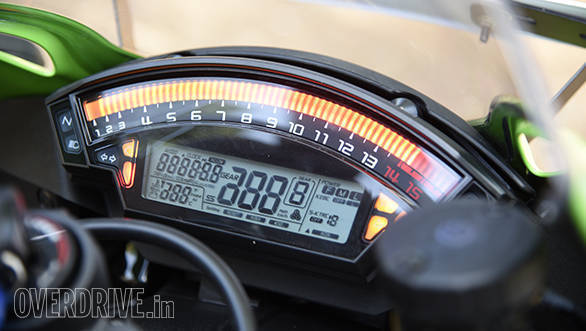 Peak power comes in at 13,000rpm
Peak power comes in at 13,000rpm
First, the crank is now lighter which not only results in a quicker revving engine but also benefits racers as reduced reciprocating mass means better corner turn-in and easier side-to-side transitions. The crank balancer is now lighter, and the connecting rod journals have a new coating for even lower friction. Intake and exhaust ports in the head are revised with a straighter cross section that improves airflow, thereby increasing power. On the earlier model, only the intake ports were polished, but now they exhaust ports get the same treatment. It's a similar story with the valves â" earlier only intake valves were titanium, now all four are built in the same material. The combustion chamber shape is slightly changed, and the titanium exhaust valves get 1mm more in diameter for a total of 25.5mm. Both these changes increase high rev power output. Intake and exhaust cam profiles now allow greater overlap for increased high rpm power, and a new cam chain tensioner promises more accurate valve timing as well as reduced mechanical noise.
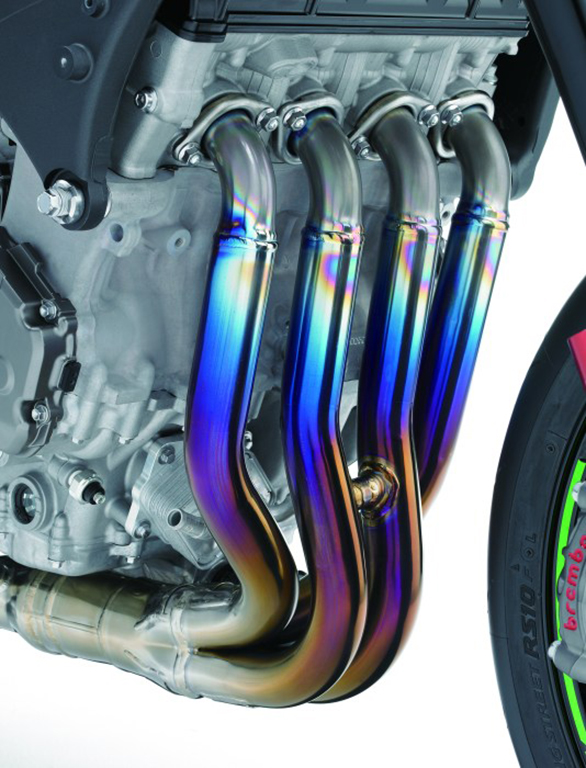 Mmm ... titanium pipes!
Mmm ... titanium pipes!
The pistons are brand new, cast from a new heat-resistant alloy that reduces weight by 5gm each but assures improved durability. A new dry-film lubricant coating on the piston skirts is said to reduce low rpm friction and help with the engine break-in process. For 2016, the ZX-10R gets a 25 per cent bigger airbox and a new air filter that offer 60 per cent better air flow. This improves low- to mid-range performance which is equally important on corner exits. New electronic throttle valves precisely control the intake airflow and allow seamless integration of the new rider aids that we will discuss below. The new throttle bodies brought with them a new ECU that resides in its own aluminium case under the seat. The gearbox is a cassette type 6-speed close ratio unit that was derived from the racetrack. 1st gear is still very tall, but 2nd-6th gears are now more closely arranged.
Finally, the titanium exhaust system is new, and Kawasaki claims it offers better mass centralisation properties as well as a 50 per cent larger volume than before which improves the bike's balance and reduces sound levels, respectively.
Electronics
Finally, we come to the big talking point of the 2016 Kawasaki Ninja ZX-10R â" the comprehensive electronics package. This electronic suite was born through the implementation of a Bosch 5-axis IMU. This is basically a device that measures details like pitch, roll, acceleration fore-aft, up down and left right. The sixth axis is yaw, which occurs during a powerslide where the front wheel is out of line with the sliding rear. This marks the difference between the Yamaha R1 and the Kawasaki as the R1 uses a 6-axis IMU that physically records yaw rate whereas the digitally calculates the same through its ECU.
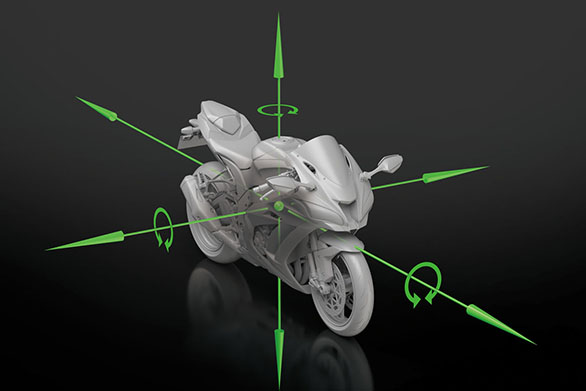 The new Bosch IMU measures five axes and the ECU uses Kawasaki software to measure the sixth
The new Bosch IMU measures five axes and the ECU uses Kawasaki software to measure the sixth
The data gleaned through the IMU provides another level of precision to the electronics package. The IMU input is used by the ECU along with measurements of throttle position, engine rpm and throttle open sensors. Such a high level of chassis monitoring means that the electronics can adapt even to changes in road camber or if different tyres are used. What this means is that the electronics package can now respond to road conditions in real time as against simple preset parameters that older traction control systems had to rely on.
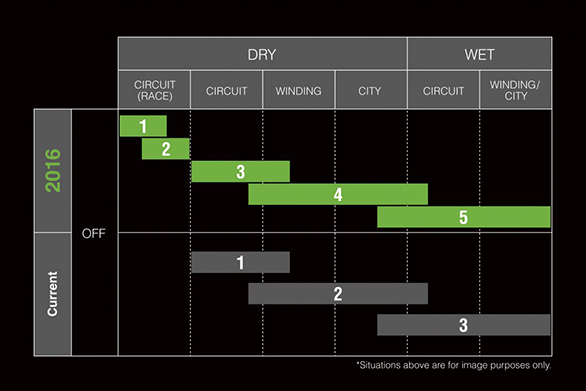 Five traction control modes on the new bike vs the three modes on the old one
Five traction control modes on the new bike vs the three modes on the old one
Where the old bike had three levels of traction control, the new 10R offers five through its S-KTRC system (Sport Kawasaki Traction Control). Kawasaki says Modes 1 and 2 are for racers on track. Mode 3 is for a dry circuit with high-performance tyres. Mode 4 for dry mountain roads or commuting, and Mode 5, which is the strictest, keeps things safe in the wet. To gain the best lap times, some amount of slippage is required which is what the first 3 modes offer. I spent a majority of my day in Mode 1 and had almost no interference, probably because I wasn't pushing hard enough considering I was on a public road. I, however, did notice that when the bike slid on a new, unscrubbed tyre that traction control brought it back rather abruptly. Only a track test will reveal more on just how good the electronics are. On the road, they work well.
Kawasaki Intelligent Braking System or KIBS is essentially Kawasaki talk for ABS. The system uses multiple brake sensors to regulate brake pressure as required. It's one of the best systems I have experienced and never engaged once, even when I tried some careful but reasonably firm braking on fine gravel at about 30kmph!
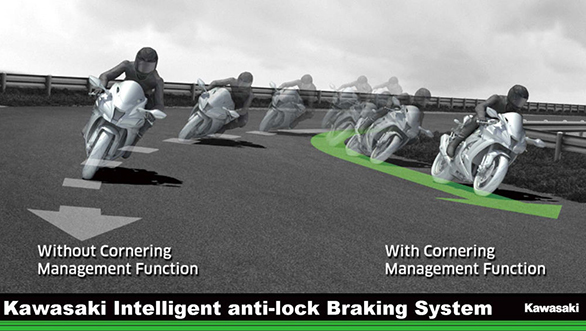
Corner Management Function or CMF uses both KIBS and the IMU to detect if the rider has gotten on the brakes too firmly in a corner. Usually, if the rider misjudges the radius of the corner and instinctively gets on the brakes too hard, the bike tends to stand up and be drawn wide out of the corner. CMF detects the level of lean, and the traction available controls the amount of brake pressure applied. Less brake pressure means the front fork will decompress a little, allowing the bike to stay leaned over and take a tighter turn. The system will only work if you get into a situation where there's too much brake applied at high lean and we couldn't bring ourselves to try that out on a brand-new Rs 18 lakh motorcycle!
Kawasaki Engine Braking Control or KEBC is a system that injects a bit of fuel in on a closed throttle to reduce the engine braking effect. This is a feature that only racers will appreciate as reduced engine braking puts less load on the front suspension when setting up for a corner, allowing the rider to set up the corner entry more precisely on the brakes. The feature can either be turned on or off and doesn't offer an adjustability. As the bike we rode was new, Kawasaki requested us not to use the launch control system or this, so we didn't.
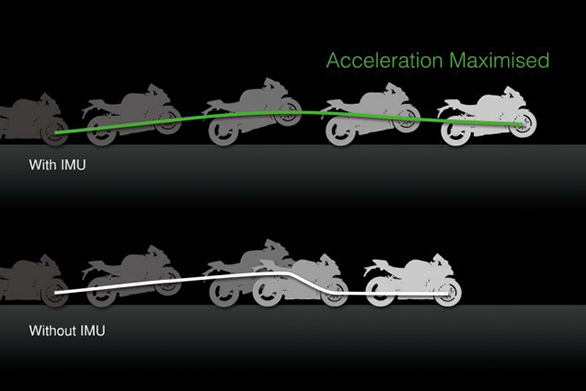 KLCM is designed to give maximum drive with limited wheel spin and controlled front wheel lift
KLCM is designed to give maximum drive with limited wheel spin and controlled front wheel lift
Kawasaki Launch Control Mode or KLCM is a new, three-stage system that allows for the cleanest, hardest launch off the line. The three modes offer launches in varying levels of violence based on how skilled the rider is. Level one offers least electronic resistance but demands more from the rider in terms of throttle and clutch management. Level two finds a middle ground while level three allows the rider to simply drop the clutch and keep the throttle pinned wide open with the electronics doing most of the work by minimising wheelspin and keeping the front wheel from getting too high off the tarmac. Launch control can be selected only with power mode Full.
Selectable power modes were available on the last gen ZX-10R as well. The 2016 model offers three modes: Full mode delivers what it promises while Low mode restricts power to 60 per cent, or about 120PS. Middle mode is interesting, it reduces power to about 80 per cent, but if you wind the throttle beyond the halfway mark, it recognizes that more power is desired and gives you access to all 200PS.
Kawasaki Quick Shifter or KQS is one of my favourite additions on this bike. This upshift only quick-shifter works via a contactless sensor and allows the rider to shift up through the gears with the throttle wide open by simply nudging the shift lever up with the boot. The system works flawlessly, and we never experienced a false neutral through the day.
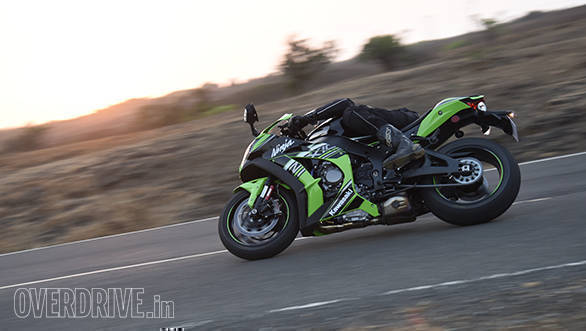
All these systems combine to make what is essentially a fire-breathing monster an inviting and forgiving bike to ride. The  ZX-10R is easy at slow speeds and a thrilling but more or less manageable experience when you are riding at your limit. Click here for the full riding experience!













